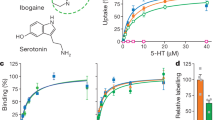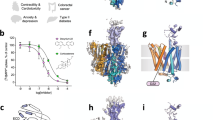Abstract
Sodium-coupled transporters are ubiquitous pumps that harness pre-existing sodium gradients to catalyse the thermodynamically unfavourable uptake of essential nutrients, neurotransmitters and inorganic ions across the lipid bilayer1. Dysfunction of these integral membrane proteins has been implicated in glucose/galactose malabsorption2, congenital hypothyroidism3, Bartter’s syndrome4, epilepsy5, depression6, autism7 and obsessive-compulsive disorder8. Sodium-coupled transporters are blocked by a number of therapeutically important compounds, including diuretics9, anticonvulsants10 and antidepressants11, many of which have also become indispensable tools in biochemical experiments designed to probe antagonist binding sites and to elucidate transport mechanisms. Steady-state kinetic data have revealed that both competitive12,13 and noncompetitive14,15 modes of inhibition exist. Antagonist dissociation experiments on the serotonin transporter (SERT) have also unveiled the existence of a low-affinity allosteric site that slows the dissociation of inhibitors from a separate high-affinity site16. Despite these strides, atomic-level insights into inhibitor action have remained elusive. Here we screen a panel of molecules for their ability to inhibit LeuT, a prokaryotic homologue of mammalian neurotransmitter sodium symporters, and show that the tricyclic antidepressant (TCA) clomipramine noncompetitively inhibits substrate uptake. Cocrystal structures show that clomipramine, along with two other TCAs, binds in an extracellular-facing vestibule about 11 Å above the substrate and two sodium ions, apparently stabilizing the extracellular gate in a closed conformation. Off-rate assays establish that clomipramine reduces the rate at which leucine dissociates from LeuT and reinforce our contention that this TCA inhibits LeuT by slowing substrate release. Our results represent a molecular view into noncompetitive inhibition of a sodium-coupled transporter and define principles for the rational design of new inhibitors.
This is a preview of subscription content, access via your institution
Access options
Subscribe to this journal
Receive 51 print issues and online access
$199.00 per year
only $3.90 per issue
Buy this article
- Purchase on Springer Link
- Instant access to full article PDF
Prices may be subject to local taxes which are calculated during checkout




Similar content being viewed by others
Change history
23 August 2007
The AOP version of this paper carried some textual errors, which have now been corrected for both print and online publication on 23 August 2007
References
Hediger, M. A. et al. The ABCs of solute carriers: physiological, pathological and therapeutic implications of human membrane transport proteins. Introduction. Pflugers Arch. 447, 465–468 (2004)
Wright, E. M., Turk, E. & Martin, M. G. Molecular basis for glucose-galactose malabsorption. Cell Biochem. Biophys. 36, 115–121 (2002)
Pohlenz, J. & Refetoff, S. Mutations in the sodium/iodide symporter (NIS) gene as a cause for iodide transport defects and congenital hypothyroidism. Biochimie 81, 469–476 (1999)
Simon, D. B. et al. Gitelman’s variant of Bartter’s syndrome, inherited hypokalaemic alkalosis, is caused by mutations in the thiazide-sensitive Na-Cl cotransporter. Nature Genet. 12, 24–30 (1996)
Richerson, G. B. & Wu, Y. Role of the GABA transporter in epilepsy. Adv. Exp. Med. Biol. 548, 76–91 (2004)
Hahn, M. K. & Blakely, R. D. Monoamine transporter gene structure and polymorphisms in relation to psychiatric and other complex disorders. Pharmacogenomics J. 2, 217–235 (2002)
Sutcliffe, J. S. et al. Allelic heterogeneity at the serotonin transporter locus (SLC6A4) confers susceptibility to autism and rigid-compulsive behaviors. Am. J. Hum. Genet. 77, 265–279 (2005)
Ozaki, N. et al. Serotonin transporter missense mutation associated with a complex neuropsychiatric phenotype. Mol. Psychiatry 8, 933–936 (2003)
Beaumont, K., Vaughn, D. A. & Fanestil, D. D. Thiazide diuretic drug receptors in rat kidney: identification with [3H]metolazone. Proc. Natl Acad. Sci. USA 85, 2311–2314 (1988)
Krogsgaard-Larsen, P., Frolund, B. & Frydenvang, K. GABA uptake inhibitors. Design, molecular pharmacology and therapeutic aspects. Curr. Pharm. Des. 6, 1193–1209 (2000)
Barker, E. L. & Blakely, R. D. in Psychopharmacology—the Fourth Generation of Progress (eds Bloom, F. E. & Kupfer, D. J.) 321–333 (Raven, New York, 1995)
Talvenheimo, J., Nelson, P. J. & Rudnick, G. Mechanism of imipramine inhibition of platelet 5-hydroxytryptamine transport. J. Biol. Chem. 254, 4631–4635 (1979)
Smart, L. Competitive inhibition of sodium-dependent high affinity choline uptake by harmala alkaloids. Eur. J. Pharmacol. 75, 265–269 (1981)
Vroye, L. et al. The Na+-I- cotransporter of the thyroid: characterisation of new inhibitors. Pflugers Arch. 435, 259–266 (1998)
Uryu, K. et al. Inhibition by neuromuscular blocking drugs of norepinephrine transporter in cultured bovine adrenal medullary cells. Anesth. Analg. 91, 546–551 (2000)
Neubauer, H. A., Hansen, C. G. & Wiborg, O. Dissection of an allosteric mechanism on the serotonin transporter: a cross-species study. Mol. Pharmacol. 69, 1242–1250 (2006)
Yamashita, A., Singh, S. K., Kawate, T., Jin, Y. & Gouaux, E. Crystal structure of a bacterial homologue of Na+/Cl--dependent neurotransmitter transporters. Nature 437, 215–223 (2005)
Zahniser, N. R. & Doolen, S. Chronic and acute regulation of Na+/Cl--dependent neurotransmitter transporters: drugs, substrates, presynaptic receptors, and signaling systems. Pharmacol. Ther. 92, 21–55 (2001)
Cantu, M. D., Hillebranda, S. & Carrilho, E. Determination of the dissociation constants (pKa) of secondary and tertiary amines in organic media by capillary electrophoresis and their role in the electrophoretic mobility order inversion. J. Chromatogr. A. 1068, 99–105 (2005)
Zomot, E. & Kanner, B. I. The interaction of the γ-aminobutyric acid transporter GAT-1 with the neurotransmitter is selectively impaired by sulfhydryl modification of a conformationally sensitive cysteine residue engineered into extracellular loop IV. J. Biol. Chem. 278, 42950–42958 (2003)
Norregaard, L., Frederiksen, D., Nielsen, E. O. & Gether, U. Delineation of an endogenous zinc-binding site in the human dopamine transporter. EMBO J. 17, 4266–4273 (1998)
Ju, P., Aubrey, K. R. & Vandenberg, R. J. Zn2+ inhibits glycine transport by glycine transporter subtype 1b. J. Biol. Chem. 279, 22983–22991 (2004)
Mitchell, S. M., Lee, E., Garcia, M. L. & Stephan, M. M. Structure and function of extracellular loop 4 of the serotonin transporter as revealed by cysteine-scanning mutagenesis. J. Biol. Chem. 279, 24089–24099 (2004)
Jardetzky, O. Simple allosteric model for membrane pumps. Nature 211, 969–970 (1966)
Zhang, Y. W. & Rudnick, G. The cytoplasmic substrate permeation pathway of serotonin transporter. J. Biol. Chem. 281, 36213–36220 (2006)
Keller, P. C., Stephan, M., Glomska, H. & Rudnick, G. Cysteine-scanning mutagenesis of the fifth external loop of serotonin transporter. Biochemistry 43, 8510–8516 (2004)
Henry, L. K., Adkins, E. M., Han, Q. & Blakely, R. D. Serotonin and cocaine-sensitive inactivation of human serotonin transporters by methanethiosulfonates targeted to transmembrane domain I. J. Biol. Chem. 278, 37052–37063 (2003)
Paczkowski, F. A., Sharpe, I. A., Dutertre, S. & Lewis, R. J. χ-Conotoxin and tricyclic antidepressant interactions at the norepinephrine transporter define a new transporter model. J. Biol. Chem. 282, 17837–17844 (2007)
Henry, L. K. et al. Tyr-95 and Ile-172 in transmembrane segments 1 and 3 of human serotonin transporters interact to establish high affinity recognition of antidepressants. J. Biol. Chem. 281, 2012–2023 (2006)
Kaplan, R. S. & Pedersen, P. L. Determination of microgram quantities of protein in the presence of milligram levels of lipid with amido black 10B. Anal. Biochem. 150, 97–104 (1985)
Acknowledgements
We thank D. C. LaPorte, R. D. Blakely, and G. Rudnick for insightful comments; M. Post for information on TCA crystallographic numbering; C. Piscitelli for assistance with LeuT purification and electrostatic calculations; L. Vaskalis for Fig. 4a, d; and the staff at beamlines X26C and X29A of the National Synchrotron Light Source and beamline 8.2.2 of the Advanced Light Source for assistance with X-ray data collection. S.K.S. was supported by an individual NIH National Research Service Award. This work was supported by the NIH. E.G. is an investigator with the Howard Hughes Medical Institute.
Coordinates and structure factors for the alanine–sodium–clomipramine and the leucine–sodium–clomipramine, –imipramine and –desipramine complexes have been deposited in the Protein Data Bank under accession codes 2QEI, 2Q6H, 2Q72 and 2QB4, respectively.
Author information
Authors and Affiliations
Corresponding author
Ethics declarations
Competing interests
Reprints and permissions information is available at www.nature.com/reprints. The authors declare no competing financial interests.
Supplementary information
Supplementary Information
This file contains Supplementary Figures S1-S4 with Legends, Supplementary Tables 1 and 2, Supplementary Methods and Supplementary Notes with additional references. (PDF 1777 kb)
Rights and permissions
About this article
Cite this article
Singh, S., Yamashita, A. & Gouaux, E. Antidepressant binding site in a bacterial homologue of neurotransmitter transporters. Nature 448, 952–956 (2007). https://doi.org/10.1038/nature06038
Received:
Accepted:
Published:
Issue Date:
DOI: https://doi.org/10.1038/nature06038
This article is cited by
-
The Lepidopteran KAAT1 and CAATCH1: Orthologs to Understand Structure–Function Relationships in Mammalian SLC6 Transporters
Neurochemical Research (2022)
-
Structural insights into the inhibition of glycine reuptake
Nature (2021)
-
The mechanism of a high-affinity allosteric inhibitor of the serotonin transporter
Nature Communications (2020)
-
The Amino Terminus of LeuT Changes Conformation in an Environment Sensitive Manner
Neurochemical Research (2020)
-
Conformational dynamics of the human serotonin transporter during substrate and drug binding
Nature Communications (2019)
Comments
By submitting a comment you agree to abide by our Terms and Community Guidelines. If you find something abusive or that does not comply with our terms or guidelines please flag it as inappropriate.



